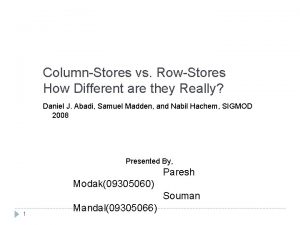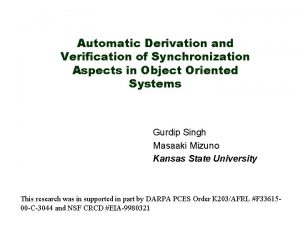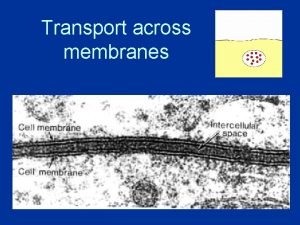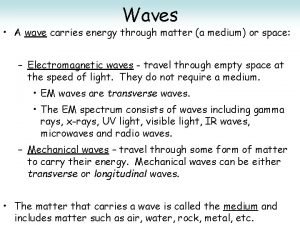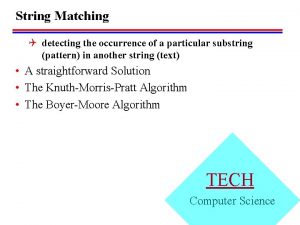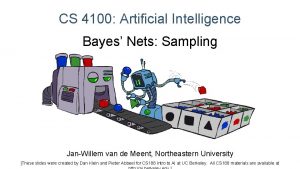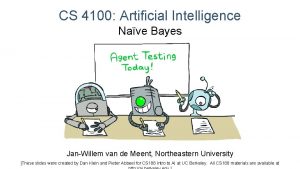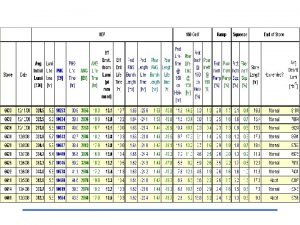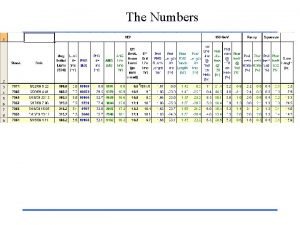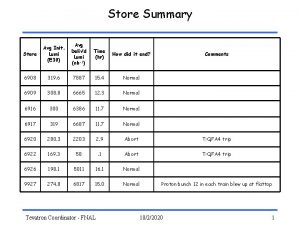Store Atomicity What does atomicity really require JanWillem





























![Well synchronized programs [Adve, Hill 90] [Keleher, Cox, Zwaenepoel 92] Divide the variables in Well synchronized programs [Adve, Hill 90] [Keleher, Cox, Zwaenepoel 92] Divide the variables in](https://slidetodoc.com/presentation_image/dbf6d142c0d0225d753649d8434d9a5f/image-30.jpg)


- Slides: 32

Store Atomicity What does atomicity really require? Jan-Willem Maessen (Sun Microsystems) Based on joint work with Arvind from ISCA’ 06 From Dataflow to Synthesis May 18, 2007 1

What is atomic memory? Monolithic memory Memory, cache, buffers P P Out of order processors Operational view: instruction at a time Declarative view: serializability Dataflow to Synthesis, May 18, 2007 2

The Atomicity Puzzle Dataflow to Synthesis, May 18, 2007 3

Puzzle 1: Serializability Sx 1 L x=1 Sy 2 L y=2 S y 2 source(L) S x 1 Sy 2 L x=1 L y=2 Sy 2 Sx 1 L y=2 L x=1 Sy 2 L y=2 Sx 1 L x=1 Sx 1 Sy 2 L y=2 L x=1 L y=2 L Many serializations exist for a given execution Dataflow to Synthesis, May 18, 2007 4

Puzzle 1: Serializability Sx 1 L x=1 Sx 2 L x=2 Only two serializations are possible Dataflow to Synthesis, May 18, 2007 Sx 1 L x=1 Sx 2 L x=2 Sx 1 Sx 2 L x=1 L x=2 Sx 1 L x=2 L x=1 Sx 2 L x=2 Sx 1 L x=1 Sx 2 L x=1 5

Potential violations of Serializability: Example 1 Thread 1 S x, 1 Fence S y, 2 Ly = L 3 x Thread 2 S y, 3 Fence S x, 4 = 1? Sx 1 Sy 3 Sy 2 Sx 4 Ly Lx Predecessor Stores of a Load are ordered before its source Dataflow to Synthesis, May 18, 2007 6

Potential violations of Serializability: Example 2 Thread 1 S x, 2 Fence Ly = L x 3 Thread 2 S y, 3 S y, 5 Fence = 1? Sx 1 Sy 3 Sx 2 Sy 5 Ly Lx Successor Stores of a Store are ordered after its observer Dataflow to Synthesis, May 18, 2007 7

For Serializability we must have. . . Sx Sx Lx Sx Predecessor Stores of a Load are ordered before its source Successor Stores of a Store are ordered after its observer Surprisingly not enough to ensure serializability! Recognized by Hangal, Vahia, Manovit, et al. [TSOtool, ISCA ‘ 04] Dataflow to Synthesis, May 18, 2007 8

Must pay attention to pairs of unrelated observations. . . Sx Lx Mutual In any serialization, ancestors of unordered one S-L pair Loads mustare precede ordered thebefore other mutual successors of theyinstructions observe Two legal interleavings of. Stores these four Overconstraining rules out legal executions Dataflow to Synthesis, May 18, 2007 9

Potential violations of Serializability: Example 3 Thread 1 S x, 1 Fence Ly =2 Ly =4 Thread 2 Thread 3 S y, 2 S y, 4 Fence S z, 6 Lz Fence S x, 8 Lx =6 = 1? Sx 1 Sy 2 Sy 4 Ly Sz 6 Lz Ly Sx 8 Lx Dataflow to Synthesis, May 18, 2007 10

Store Atomicity Sx Sx Sx Lx Predecessor Stores of a Load are ordered before its source Successor Stores of a Store are ordered after its observer Mutual ancestors of unordered Loads are ordered before mutual successors of the Stores they observe Claim: Store Atomicity guarantees Serializability Dataflow to Synthesis, May 18, 2007 11

Instruction Reordering 2 nd 1 st +, . . . Br Ly S y, w +, . . . indep indep x≠y x≠y Fence Br Lx S y, w Fence Dataflow to Synthesis, May 18, 2007 12

Programming Language viewpoint Pointers and array indices give rise to dependent loads; these operations must be ordered. r 1 = L x r 2 = L [r 1] r 3 = r 2 + 1 S [r 1], r 3 Lx L [r 1] r 2+1 Flow of register state reflected in edges of graph; implicit register renaming S [r 1], r 3 Dataflow to Synthesis, May 18, 2007 13

Address Speculation Sy 2 Sy 4 r=Lx Sr 7 ? Sxz Ly S r 7 and L y are ordered if r = y Non-speculative execution must wait until r has been computed. Speculation assumes r ≠ y; if this fails, discard the execution Speculation = any decision which may break the rules down the line. Here we relax the reordering axioms. Behavior consistent with Store Atomicity observed by [Martin, Sorin, Cain, Hill, Lipasti 01] Dataflow to Synthesis, May 18, 2007 14

Optimizations Are Tricky Thread 1 Sx 0 r 1 = L x = 2 r 2 = L x if (r 1 = r 2) Sy 2 Thread 2 Sy 0 r 3 = L y = 2 S x, r 3 Ban invention of values “out of thin air” Permit any other imaginable optimization [Manson, Pugh, Adve 05] Dataflow to Synthesis, May 18, 2007 15

TSO is Non-Atomic Sx 1 Sy 5 Sx 2 Sy 7 Sz 3 Sz 8 Lz Lz Ly Lx Dataflow to Synthesis, May 18, 2007 Satisfy some Loads with local Stores Memory order ignores them Makes model non-atomic 16

Transactional Serializability Serialize instructions in transaction together. Clearly atomic Too strong; can’t interleave independent operations Sx 1 L x=1 Sy 2 L y=2 Disllowed executions actually are ok for this example! Dataflow to Synthesis, May 18, 2007 Sx 1 L x=1 Sy 2 L y=2 Sx 1 Sy 2 L x=1 L y=2 Sy 2 Sx 1 L y=2 L x=1 Sy 2 L y=2 Sx 1 L x=1 Sx 1 Sy 2 L y=2 L x=1 17

Ordering and transactions Trans Op Commit Predecessor operations precede the start of a transaction Successor operations follow the end of a transaction Dataflow to Synthesis, May 18, 2007 18

Enumeration of legal behaviors Find all legal behaviors Must get the edges right Find one legal behavior Can impose unnecessary ordering Example: invalidation-based cache Dataflow to Synthesis, May 18, 2007 19

Choosing a candidate Store Lx Sx 1 Sx 4 Sy 2 Sx 3 Ly Ly Lx Sx 5 Resolved instructions Frontier Sy 6 Unresolved instructions Candidate stores for a Load must be: To same address as that Load Resolved Not overwritten Guarantees Store Atomicity is maintained Dataflow to Synthesis, May 18, 2007 20

Store Atomicity Summary High-level unifying property for memory consistency protocols Separation between processor local, memory behavior Captures ordering dependencies which must be enforced by memory system A memory model with no memory Dataflow to Synthesis, May 18, 2007 21

Thanks! Jan. Willem. Maessen@sun. com 22

Implications / Applications Address Speculation, new behaviors but no violation of Store Atomicity (SA) Non-atomic models, e. g. , TSO Properly synchronized programs Java Memory Model Transactional memory Dataflow to Synthesis, May 18, 2007 23

Permit Aliasing Speculation New behaviors do not violate Store Atomicity Exploited by current architectures Banning complicates reordering Dependency from source of Store address to any subsequent Load/Store Dataflow to Synthesis, May 18, 2007 24

Overview Serializability, graphs Instruction Reordering Store Atomicity Enumerating behaviors operationally Putting Store Atomicity to use Address aliasing speculation TSO Dataflow to Synthesis, May 18, 2007 25

Drawbacks of TSO Complicates memory model Two kinds of source edges—local, non-local Must track interaction of these orderings Definition of candidates(L) is subtle Problem on multi-core architectures Separate Load/Store buffer per thread Each must be large to tolerate latency Avoid any model which treats some threads differently from others Dataflow to Synthesis, May 18, 2007 26

Multithreaded Languages Discipline programmer must follow Locks in well-synchronized programs Use of synchronized and volatile in the Java™ Programming Language Obey discipline Atomicity (SC) Every model has an atomic aspect: Lock ordering Volatile variables Dataflow to Synthesis, May 18, 2007 27

Looking ahead Exploit flexible ordering constraints Cache protocols Cross-thread speculation Transactional memory Serialization which reflects practice Programmer-level memory models Well-synchronized programs Implement language-level models in Store Atomic setting Dataflow to Synthesis, May 18, 2007 28

Programmer’s view High-level vs. low-level models Store Atomicity is a very low-level property Specifies what happens No intuition about “how to program” Programmer-level models are important Give a discipline for programming Strong model (SC) within discipline Hope: can check compliance Example: Properly synchronized programs Dataflow to Synthesis, May 18, 2007 29
![Well synchronized programs Adve Hill 90 Keleher Cox Zwaenepoel 92 Divide the variables in Well synchronized programs [Adve, Hill 90] [Keleher, Cox, Zwaenepoel 92] Divide the variables in](https://slidetodoc.com/presentation_image/dbf6d142c0d0225d753649d8434d9a5f/image-30.jpg)
Well synchronized programs [Adve, Hill 90] [Keleher, Cox, Zwaenepoel 92] Divide the variables in two classes: synchronization variables and the rest In a well synchronized program a non-synchronizing Load L has only one element in candidates(L)! Atomicity edges can be grouped and drawn lazily Dataflow to Synthesis, May 18, 2007 30

Instruction Reordering 2 nd 1 st +, . . . Ly S y, w +, . . . indep Lx indep x≠y x≠y S y, w Fence Trans Commit Fence Trans N/A Commit N/A Partial order (dag) ≺local on local instructions. Dataflow to Synthesis, May 18, 2007 31

Resolving Transactional Loads in Parallel We resolve a load in both transactions Sx 1 Sy 2 Trans Ly Lx Sx 5 Sy 6 Results in a cycle between transactions Commit Roll back some Load which breaks cycle Commit Observed Stores overwritten Bad speculation introduces cycle Roll back Load which break cycle Along with its direct dependencies Dataflow to Synthesis, May 18, 2007 32
 Row store vs column store
Row store vs column store Row store vs column store
Row store vs column store Atomicity
Atomicity Atomicity
Atomicity Recovery and atomicity
Recovery and atomicity 3 types of active transport
3 types of active transport Apa formatting title
Apa formatting title Does simple diffusion require energy
Does simple diffusion require energy Integral and peripheral proteins
Integral and peripheral proteins Does facilitated diffusion require a transport protein
Does facilitated diffusion require a transport protein What does the lord require of you? - deuteronomy
What does the lord require of you? - deuteronomy Does osmosis require energy
Does osmosis require energy Does osmosis require a partially permeable membrane
Does osmosis require a partially permeable membrane Does osmosis require energy
Does osmosis require energy Superior strategy execution capabilities are
Superior strategy execution capabilities are What does the lord require of you deuteronomy
What does the lord require of you deuteronomy Does bc require css profile
Does bc require css profile Cups on a string
Cups on a string Asexual and sexual reproduction difference
Asexual and sexual reproduction difference Similarities of mechanical and electromagnetic waves
Similarities of mechanical and electromagnetic waves Waves that transmit energy through matter or empty space
Waves that transmit energy through matter or empty space What are the 4 main types of assistance that users require?
What are the 4 main types of assistance that users require? Reserve ratio
Reserve ratio What waves don't require a medium
What waves don't require a medium Principal forms of verbs
Principal forms of verbs Errors discovered after posting has taken place requires
Errors discovered after posting has taken place requires What waves don't require a medium
What waves don't require a medium What waves don't require a medium
What waves don't require a medium How are mechanical waves created
How are mechanical waves created My dog romeo essay
My dog romeo essay Kmp flowchart construction require
Kmp flowchart construction require Most letter formats require single spacing.
Most letter formats require single spacing. Key resources examples
Key resources examples

